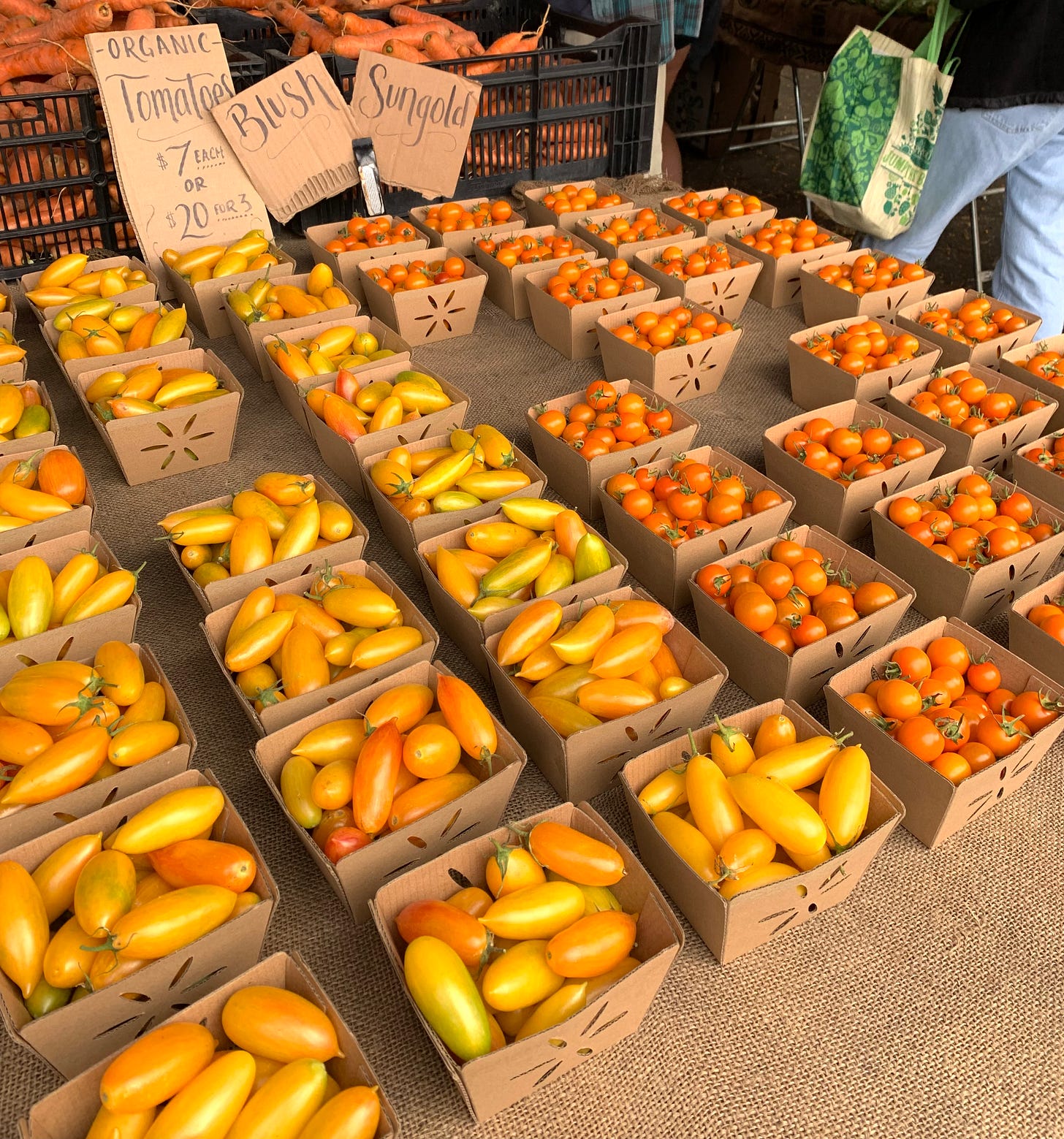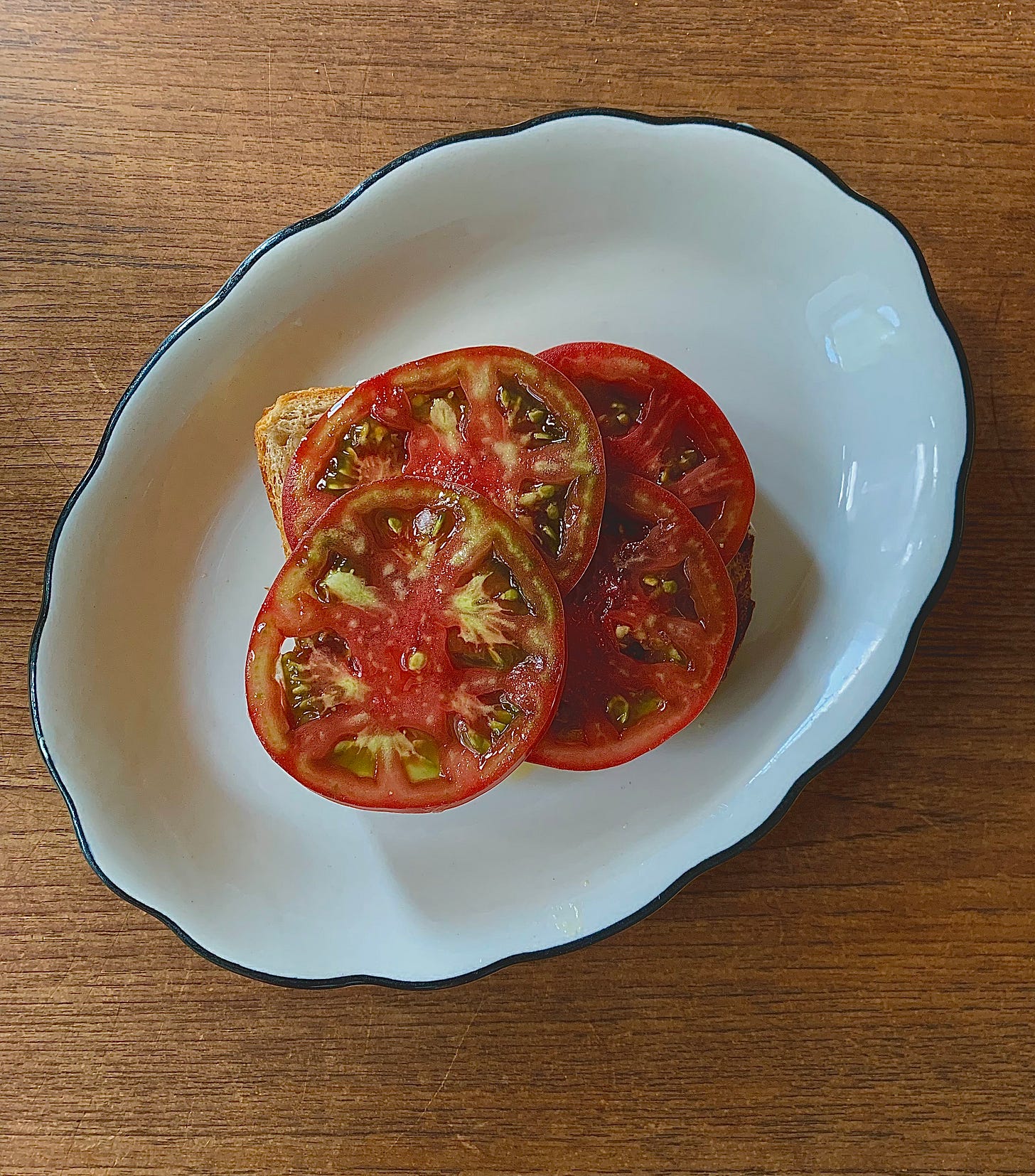It’s tomato season - the uncontested best time of year. I’m writing this from the third floor of a townhouse, in our apartment that locks in heat so greedily. Though I’m perspiring from the act of typing, I still believe that when tomatoes are abundant, there is something quite right with the universe.1 Below are four ways to employ the joyful tomato glut. To eat now or to stow away for the colder months. Tomatoes are full of water, so the trick is using either salt or heat to remove the excess and concentrate their flavor. Salt will coerce the tomato to release some of its liquid, while heat - through boiling, roasting, or dehydrating - will encourage it to evaporate.
Burst Sungold Cherry Tomato Sauce
Sungold Tomato Sauce, Poached Sablefish, Basil, Cornflower
Peel 6 garlic cloves and slice thin. In a dutch oven, or deep rimmed sauté pan, add 1/2 cup of good olive oil. Warm the oil over medium heat and add garlic. Let it soften for a few minutes. Add in 1/2 teaspoon Aleppo pepper or red chili flakes. Once the garlic starts to just barely get golden, add in a pint of washed Sungold tomatoes. They will start to sputter and spit. Put a lid on it for a minute or two. Add in a splash of dry white wine (1/2 cup approximately) and put the lid back on. Remove the lid after many of the tomatoes have burst. With the back of a wooden spoon, press on the remaining whole tomatoes to help them release their juices. Season with salt. Let it all cook down and concentrate for 3-5 minutes, then remove from heat.
I like to spoon this sauce over oven poached Sablefish or grilled Branzino. Of course, it is also delicious over spaghetti with grated Parmigiano and basil.
Tomato Toast
I average five tomato toasts a week during peak season. This current iteration, with butter and anchovies is on repeat.
Slice an heirloom tomato thinly and sprinkle with crunchy sea salt. Place on a paper or kitchen towel to soak up the moisture that the salt pulls out while you’re making the toast. Cut a thick slice of sourdough bread and toast it. Remove from toaster and rub it thoroughly with a garlic clove. Spread a generous amount of butter on toast, or drizzle with olive oil if that’s your preference. Spread three, high quality anchovies across the top. Place your tomatoes over the anchovies and garnish with torn basil leaves.
Preserved Tomatoes
Every year, I go to a farm and purchase a box of their “seconds” tomatoes (I bet you could inquire with your favorite farmer’s market vendor too). Seconds are produce that don’t meet the standard of quality or appearance to be sold at the normal price. They are cheaper and are perfect for canning tomatoes. I like to can my tomatoes by adding as little as possible to them, so that when it comes time to use them in the fall, winter, and spring, they are versatile. Make sure the lids of your jars have never been used before, or else they will not seal properly.
Step 1: Turn your over to 210℉. Sanitize the jars and lids separately, either washing by hand or sending them through a dishwasher cycle. Once sanitized, place the jars and lids in the oven as you prepare the tomatoes.
Step 2: Place a large put of water on to boil. Make an ice bath by filling a large bowl with ice and water.
Step 3: Score your tomatoes. With a pairing or birds beak knife, score a shallow x on the side of the tomato that was not attached to the vine. Remove the stem end side as well by holding your knife at an acute angle to the tomato and moving it circularly around the stem.
Step 4: Drop tomatoes one by one in boiling water. Remove with a spider or strainer when you see the skin begin to pull back or wrinkle. Drop into the ice bath. You can work in batches depending on how many tomatoes you are blanching, but once they are cool to the touch, peel off their skin and place in a pot on the stove.
Step 5: Once all tomatoes are in the pot on the stove, use either a potato masher or simply squeeze them with your hands to break them up. Add a generous amount of salt and begin cooking down. Keep cooking until the preserved tomatoes are at least 135℉. You can continue cooking to your desired viscosity.
Step 6: Remove jars from the oven. Using a wide mouth jar filter and a ladle, portion out your tomato “sauce“ into the jars. Everything is hot in this moment, so be careful. It helps to wear gardening gloves if you have them on hand! Wipe down each jar rim with a wet paper towel or rag dipped in white vinegar, and then close with the lid. Let cool entirely. Once fully cooled the dimple of the jar lid should be sunken in, and not flexible to the touch. If the jar bounces back at you, either attempt to reseal by putting the whole jar back in the oven until you hear the ping of it sealing, or simply place it in your fridge and use it first. Place the sealed jars somewhere where people can see them! They are very beautiful.
Tomato Tart
yields 1 fully assembled tart (which serves 6-8 for a snack)
+ 1 sheet of puff and 1 cup of béchamel for another day
This is the same recipe I shared a few months back for the caramelized leek tart, but with tomatoes. It is the same process, but easier, because the tomatoes require much less prep than the leeks. This is truly a stunner of a tart, if you make it once, you’ll never stop.
Puff Pastry
You want to work quickly with this recipe in order to keep the butter cold. What makes puff pastry flaky is the distinct layers of butter striated throughout the dough. We don’t want a totally homogenous and dense dough, a result of warm butter, so we work quickly and with cold butter to avoid this. You don’t need to rush, just don’t dilly dally.
500g flour
500g butter, cubed and cold
12g sugar
12g salt
1/2 C ice water, approximately
In a bowl, mix to combine the flour, salt, and sugar. Add in the cold butter, coating in flour first then pinching the chunks of butter between your fingers to incorporate into the flour. Drizzle in 1/4 cup of ice water and begin to combine the dough with your hands. Add more water if necessary. Press the dough into two discs. It’s ok if the dough feels a little dry it will hydrate more in the fridge. Using a rolling pin, flatten out the dough then wrap in plastic wrap. Refrigerate for an hour.
Remove the dough from the fridge and lightly flour your work surface. Roll out each dough round into as much of a rectangle as possible (this does not need to be precise). What we are going for is for the length of the dough to be longer than the width. Fold the dough like a trifold pamphlet. Cover with plastic wrap or a kitchen towel and let rest in the fridge for another hour. Repeat this process one-two more times, depending on the level of flakiness you’re after. The more folds you do, the more layers you’ll get (though there is a point of diminishing return), but honestly I’ve done it both ways many times and they are both delicious. Once you’ve done all your folds, you can roll the dough out to your desired tart shape. See mine above, a rustic rectangle. After you roll out your dough, place it back in the fridge (covered) for 30 minutes or so. At this point, you can use this dough like you would the pastry dough you buy from the store. Make a tarte tatin, a pot pie, cinnamon sticks, whatever! Or continue on to make a leek tart.
Béchamel
500g milk
30g flour
30g butter
2 garlic cloves, peeled
Big pinch salt
1 tsp peppercorns
1/4 tsp ground nutmeg
Sprig or two of thyme
Put your milk in a pot and place on the stove over medium heat. Add in garlic cloves, a pinch of salt, peppercorns, nutmeg, and a spring of thyme. Bring to a simmer then turn off heat. Let steep on the stove for 15 minutes. Strain and then return to medium heat.
In another sauce pot, melt butter over medium heat. Add in flour and begin to whisk. Cook for 2 minutes, whisking constantly. Ladle in warm milk bit by bit, whisking as you go until all the milk is incorporated. Taste. Season with salt and pepper. Divide in half between two pint containers. Keep one out, label the other and freeze once it has cooled.
Tomatoes
approximately 5 beefsteak/heirloom tomatoes per tart
Slice tomato rounds from the bottom to the stem side and lay out on a rack or over paper/kitchen towels. Season each side with salt and let sit for 20 minutes to release water. This will make it so that when you go to bake the tart, you don’t end up with a soupy-doughy mess.
Assembly
We have our pastry dough, béchamel, and salted tomatoes. Now we assemble. Preheat your oven to 400°F. Line a baking sheet with parchment. Remove dough from fridge. Make a shallow indentation around the perimeter of the tart, almost like you are outlining a frame. I use a bench scraper for this, but you can also use a butter knife. Be careful not to cut down all the way through to the baking tray. You can see in the picture up top, how the leeks and béchamel are framed by pastry dough. Brush the perimeter of the dough with an egg wash (1 egg + a dash of water/milk/or cream, whisked thoroughly until homogenous).
Spread the béchamel within the frame of the dough. You’ll probably use a bit over a cup and a half of béchamel for this. Whatever you don’t use, you can add to what you have already set aside to freeze.
Organize the salted tomatoes on top of the béchamel however you’d like (see examples above and below). Finish with crunchy sea salt and cracked pepper. Bake for 20-30 minutes. At 20 minutes, start keeping an eye on the tart. Check both the bottom of the tart and the top to see how the browning is going. If you feel it needs more color on the bottom, move the tart to a lower rack. Vice versa if you feel it needs more coloring on its top. When it is golden to your liking, remove from the oven and let cool on a rack until ready to eat. Before slicing into it, add a handful of fresh oregano or basil over top.
You can make it large format like the one pictured above, or make individual sized tarts, but using a cookie cutter or tracing the perimeter of a pint container with a knife and cutting out large circles.
This was written at a time when my living room clocked in at 90°F.










Gracie, you are a genius! Of course, Salt Spring tomatoes are bursting too. And I so get it about hot and humid New York, or New England, for that matter. Our summers in Rhode Island, in the woods, were hot and humid too. Afternoons were for reading amongst the pines. I miss you. Big hugs.
The uncontested best time, indeed!